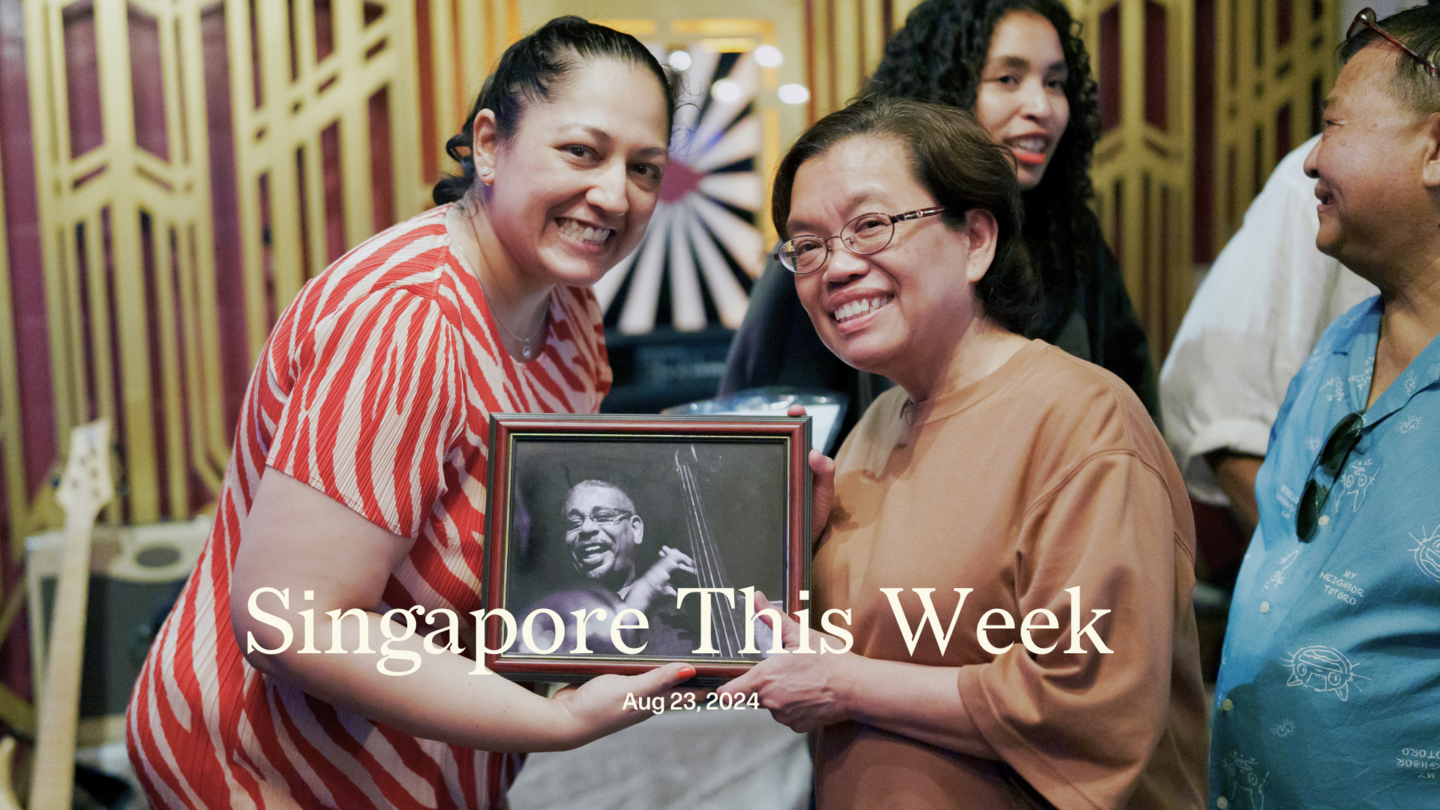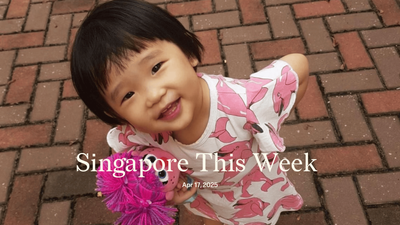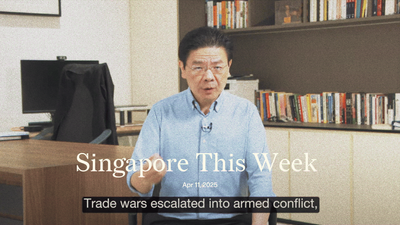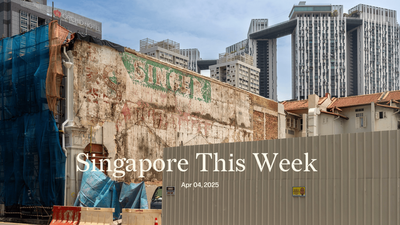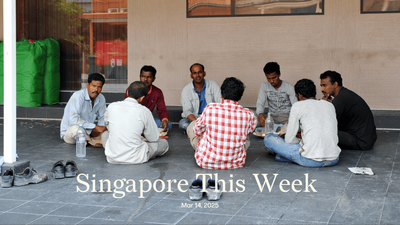Politics: All things to all people
In his inaugural National Day Rally (NDR), Lawrence Wong, prime minister, channelled the spirit of Lee Kuan Yew, by promising a government that will be prudent and bold. An oxymoron? Since assuming power in May, his messaging has combined conservative and progressive elements, seeking to uphold traditions and policies of the past while also, seemingly, being open to slaying sacred cows. Perhaps this has always been the way of the ruling People’s Action Party (PAP): from the elder Lee’s early mixing of free-market principles with the more socialistic provision of education, healthcare, and housing, to Lee Hsien Loong’s reversal of the decades-old antipathy to public gambling in the early 2000s. Fans might characterise this ideological approach as middle-of-the-road pragmatism.
The challenge for Wong is that he assumes power in an environment wholly different from his predecessors: more complex policy challenges locally and internationally; a (relatively) fractured ruling party facing an opposition more cohesive than it’s been since the 1960s; and a more demanding electorate seemingly receptive to political plurality. What was once “pragmatic” could today appear more confused and contradictory. Consider the response to the recent NDR initiatives. The Straits Times (ST) parroted Wong, calling it a “major reset of policies”. CNA interviewed one set of analysts who called them “radical”. The South China Morning Post interviewed another who said they are more “incremental”. Perhaps this simply reflects the different vantage points of an increasingly diverse electorate. (And the relative access, and biases, of the media outlets.) Said Chris Kuan, a former banker and regular social media commentator: “Yet [the fact that] the usual political commentators and analysts said that Larry the Man’s policy shifts are ‘radical’ goes to show how much these highly educated people had [sic] been gaslighted by years of government party political narratives that they can’t even tell what is really radical and what is just moving with the times in mincing steps.”
Wong will hope that his “radicalism” attracts potential opposition voters while his “incrementalism” pleases the PAP’s traditional base. But there is a risk that he comes across as a wishy-washy politician who’s trying to please everybody. Recall that Wong loves to emphasise his “ordinary family” roots and the fact that he understands the struggles of Singaporeans. “I may be prime minister,” he said at the NDR. “But I’m also a fellow citizen and friend, sharing the same experiences and concerns as all of you.” Well, at least those of you, like him, earning over S$180,000 a month.
Politics: The unbearable lite-ness
The Workers’ Party (WP), while welcoming the NDR policy shifts, wasted no time in reminding voters that many of Wong’s initiatives are strikingly similar to theirs. Singapore’s new unemployment insurance, which will offer up to S$6,000 over six months to those who’ve lost their jobs, is similar to something the WP first proposed in 2016. In its 2020 general election (GE) manifesto, the WP suggested a package equivalent to a maximum payout of S$7,200 over six months. Its manifesto also called for more shared parental maternity leave, and the party has emphasised the importance of shifting societal expectations that childcare is primarily the mum’s responsibility—precisely what Wong’s government, by raising the total government-paid parental leave to 30 weeks, is now doing. Finally, the WP noted that Wong’s attempt to enhance housing access for singles—including them in priority access schemes for Build-to-Order (BTO) flats near their families—doesn’t go nearly as far as it wants. In its 2020 manifesto, the WP called for the eligibility age for singles to apply for a BTO flat to be lowered from 35 to 28 years.
“You know Dr [Jamus] Lim, I’ve read your manifesto, and actually to be honest with you, we could have written the same manifesto,” Vivian Balakrishnan, minister for foreign affairs, told the WP’s then candidate (and now member of Parliament) during the 2020 GE debate. “And that’s why people have called the Workers’ Party PAP-lite, or PAP-like. Whatever line or stand PAP has taken, you basically use that as your reference point, and take a half step to the left.” From the PAP’s perspective, the WP is PAP-lite: one step to the left. And from the WP’s perspective, according to insiders, the PAP is WP-lite: one step to the right. Public housing is perhaps the only area where the opposition has suggested fundamental policy shifts, as Hazel Poa, leader of the Progress Singapore Party (PSP), also reiterated this week. At the next GE, due by November 2025, will opposition parties actually propose more radical manifestos, in the hope that the electorate is ready for a bigger shift? Or will they again compete not on how different they are to the PAP, but on how similar they can be?
Society: No phones please, we’re students
Several schools have enforced rules to control students’ mobile usage during curriculum hours. This includes requiring pupils to keep their devices under lock and key until the end of the day; and restricting usage to designated times and locations, such as during recess, after school, or at the foyer. Failure to comply can result in the phone being confiscated. (The shock. The horror.) Call it an “addiction”, but parents too are often the reason why it’s “quite difficult” for students to live without their phone. They use it “all the time to get in contact…to monitor them”, noted Mohamad Azhar Ibrahim, head of student management at Anglo-Chinese School (Barker Road) in an ST report. This might be necessary, say during a family emergency or if it’s health-related—a child may suffer from anxiety and needs periodic check-ins. But perhaps for the former, as in the past, calling the general office to pass on a message may suffice?
Smartphones are disruptive—they can undermine learning, break students’ concentration and threaten a child’s ability to absorb, process and retain information. And while scheduled breaks are welcomed, unplanned interruptions aren’t. One study found that it can take up to 23 minutes to refocus one’s attention after being distracted. Even UNESCO, the UN’s education, science and culture agency, has chimed into the debate, calling for smartphones to be banned last year. “Not all change constitutes progress,” it said.
Evidence for partial and outright bans remains inconclusive and oftentimes conflicting. Belgium and Spain, for instance, recorded positive outcomes, including in student performance and reduced rates of cyberbullying, but Sweden found no differences in academic achievement. Enforcement is also a challenge. Critics have decried any form of ban as draconian, patronising and out of touch; with some arguing it would hamper the students’ ability to prepare for the real world. More broadly, the Singapore government will soon put in place measures to deal with screen time and device use for addicts between 18 months and 12 years. Bans may be tempting, but to do so will be a missed opportunity for all involved—parents, teachers and students—to reach a middle ground. Afterall, isn’t it more important that the young become truly discerning users of technology, fully grasping the benefits of delayed gratification, face-to-face social interaction, as well as responsible and regulated device usage? Rather than being forced to do what they’re told.
Society: The consumption compulsion
Have less, be more. That’s the sentiment behind “underconsumption core”, the latest viral trend on TikTok. Fans are vowing more frugal and deliberate lifestyles—think patched up clothes, tubes of moisturiser squeezed to within a droplet of their lives and self-imposed, months-long shopping bans. They’re driven mostly by, it appears, the alarming spike in the cost of living, though environmental concerns are causing consternation too. And rightly so. According to this 2018 World Economic Forum commentary, rich countries like Singapore consume nearly eight times the “stuff”—food, minerals, metals, fossil fuels—that low-income ones do, on a per capita basis. Between 1990 and 2018, global consumption rose from around 50bn to 80bn tonnes, with more than 80 percent of the increase attributable to rich nations.
It’s not just the planet that could do with decluttering. A more mindful, less acquisitive approach—at scale and over time—could upend the dogma that more consumption is not only desirable but necessary for human development, according to JB MacKinnon, author of The Day the World Stopped Shopping. Such a fundamental rewiring would allow more to opt out of the rat race leaving “more time to engage with friends and family and to have long conversations. There are lots of opportunities, I think, for people to genuinely feel they have a higher quality of life.” Pipe dream? Perhaps. And yet, there is no dearth of inspiration for those looking. Other popular recent TikTok trends include “loud budgeting”—a vocalised desire to reduce spending and “deinfluencing”—telling one’s followers the things on which to not spend. The Anticonsumption subreddit has nearly a million followers.
Closer to home, there is wabi-sabi, the Buddhism-derived Japanese concept of the inherent beauty in imperfection, which inspires the restoration, rather than replacement, of old material objects. Half a century ago, Buddhism inspired the economic theorist EF Schumacher too. Western economics “tries to maximise consumption by the optimal pattern of productive effort,” he explained in Small is Beautiful: Economics as if People Mattered. Meanwhile, Buddhist economics (a term he coined and defined based on Buddhist philosophy) “tries to maximise human satisfactions by the optimal pattern of consumption.” Underconsumption core then is a good thing, although it’s ironic to see it on social media, itself the most pernicious manifestation of our consumptive propensities.
History weekly by Faris Joraimi
An Islamic college in Malaya was first proposed in the 1920s, amid growing calls for higher-education institutes designated for local communities. From 1949, Sayyid Ibrahim Omar Alsagoff, head of eponymous companies in Singapore and Arab community leader, spearheaded efforts to fund, plan and found the college. The sultan of Selangor gifted his palace in Klang to be the campus, and the Islamic College of Malaya opened in 1955, with English, Arabic and Malay as the languages of instruction. Singapore never had a Muslim university: for over a century, our Muslim scholars studied at the thousand-year-old Al-Azhar University in Cairo, Egypt, just as South-east Asian Muslims before them studied at Mecca, Bombay, the Hadhramaut and Istanbul. More recently, Singaporean ‘ulama (jurists), kadis (shari’a court judges) and asatizah (religious teachers) have graduated from Islamic academies in Jordan, Saudi Arabia, Malaysia and Indonesia.
At the latest NDR, however, Lawrence Wong announced a “Singapore College of Islamic Studies”. Several questions arise. Who will design its curriculum? What will its relationship be with Singapore’s higher-education ecosystem, as the country’s only “religious” university? How will it be structured, given the diversity of educational traditions across the Muslim world: from Kelantan’s ma’ahad schools to California’s Zaytuna College, blending Islamic scholarly tradition with American liberal arts? Will professors of “Islamic studies” from secular academia also teach alongside Muslim jurists and theologians? There’s also the issue of sectarian orientation, whether it will reflect the variety of Islam’s branches, or only be for Shafi’i Sunnism, to which the majority, but not all, Singaporean Muslims adhere.
We’ll find out in time; an announcement is made less for details than to cover Wong’s progress learning Malay. But online murmurs echo my concerns about the nature of the College’s links to the state, and whether this is yet another way for the latter to define what’s acceptable Islamic doctrine. Secular-leaning citizens may prefer such oversight, but this further institutionalisation of Islam may entrench conservatism, rather than promote imaginative and critical debates we see among Muslim literati elsewhere. When Yaacob Ibrahim, then minister for Muslim affairs first mooted the idea in 2016, he mentioned “a need for home-grown religious leaders anchored in our local multi-racial, multi-religious context” and to “ensure that religious teachers are aware of local sensitivities, and have a strong appreciation of religious harmony.” Not only does this repeat old fears about foreign Islam being intolerant, it also seems unambitious about what Islamic education in Singapore can be. You’d get more rigour and sophistication from many Indonesian pesantren. Think of what we can contribute as part of the global community of Islamic studies: reflected in the faculty, syllabus, and student body. Why not revive Singapore’s historic status as a cosmopolitan centre of Muslim thought and knowledge-production?
Arts: Do give money to the arts?
Arts donors with deep pockets gave S$50.2m to the arts last year, a minor windfall indicating some post-pandemic renewal for the sector. The annual Patron of the Arts Awards, organised by the National Arts Council (NAC), honoured over 500 patrons earlier this week. Local arts groups have long been cultivating corporate and private giving by experimenting with membership models that pledge free tickets, merch, backstage tours, naming rights and, of course, tax deductions. But they’re still heavily reliant on state funding: S$530.23m in 2022, also the highest since pre-pandemic years, according to the latest Singapore Cultural Statistics report released by the Ministry of Culture, Community and Youth. The government’s Arts & Culture Resilience Package pumped in emergency funds during the pandemic, and the Cultural Matching Fund still matches donations dollar-for-dollar, but that wasn’t enough. The sector never fully recovered from the crippling austerity of Covid-19, which saw the cancellation of hundreds of live performances, a mass exodus of artists who could no longer sustain their precarious livelihoods, as well a conservative shift in audience spending habits, with artsgoers often adopting a “wait-and-see” attitude instead of buying tickets in advance.
NAC offers a suite of funding channels, with the Major Company Scheme promising long-term economic stability alongside more ad hoc grants for specific projects (like books or EPs). Funding applications, however, remain tedious and complex. It doesn’t help that state funding comes with many strings attached, and may be revoked, as was the case for Sonny Liew’s award-winning graphic novel, The Art of Charlie Chan Hock Chye. The Major Company guidelines are clear that the council won’t prioritise companies that “[u]ndermine the authority or legitimacy of the government and public institutions” or “lobby for lifestyles seen as objectionable by the general public”. In 1995, the pioneering contemporary artist Tang Da Wu met former president Ong Teng Cheong (himself a huge arts patron) and, with Ong’s consent, donned a jacket with “Don’t Give Money To The Arts” emblazoned across the back in gold. This was the year after funding for performance art and forum theatre was effectively banned (it was reinstated in 2003). Tang told a reporter that public monies were funding “the wrong kind of art”: that which had been instrumentalised by the state or made purely for commercial gain. But the good news is that you can help fund “the right kind of art” by giving to any Singaporean artist or group you love.
Arts: Rest in peace, Christy Smith
Singapore’s jazz luminaries packed out the live music venue Blu Jaz Café earlier this week to pay tribute to an American transplant that Singapore had adopted: the late Christy Smith. Originally from Compton, California, the bassist, mentor, educator and consummate musical artist passed away earlier this month after spending over three decades in the city-state, where he’d made a home not just for himself, but for generations of young musicians finding their footing (many of whom are now raising funds to help his family with medical expenses). Jeremy Monteiro, jazz pianist, Cultural Medallion winner, and Smith’s friend for 29 years, called him “one of the very best musicians” he’d ever played with; many others lauded the jazz giant’s generosity, warmth, dedication and sheer talent.
Smith’s musical appetites were voracious and omnivorous; he also consumed and created music across Afrobeat, Motown, and classical genres, and sometimes even copped sounds from the clanging Chinese funerals that he’d hear from his flat. “New music can be anything like the chirps of everyday birds which I sometimes imitate,” he told Esplanade’s Offstage last year. “Even just picking up an instrument, it’s new music.” One of his final projects with the national performing arts centre was “FESTAC ‘77”, a part-concert, part-personal-history tour that fulfilled a personal dream. Smith revisited a transformative trip to Nigeria in 1977, where he shared the stage with musical legends Fela Kuti and Stevie Wonder. Esplanade, in its social media eulogy, described Smith as an “ambassador for his lineage of African-American music”, a crucial cultural intermediary who’d introduced it to musicians here. Monteiro delivered a message to his late friend by way of the Jazz Association (Singapore): “Heaven awaits you for that great jam session.”
Tech: PropertyGuru finds a new home
PropertyGuru Group, a leading South-east Asian property technology company, is set to go private in a US$1.1bn (S$1.44bn) acquisition by EQT Private Capital Asia. Shareholders will receive US$6.70 (S$8.78) per share, a 52 percent premium over the company’s last unaffected trading price. The deal, supported by major shareholders KKR and TPG, is expected to conclude early next year, subject to regulatory approvals. This acquisition might partly be an attempt by management to realise some shareholder gain before further drops in its value. PropertyGuru first IPO-ed in 2022 with a share price of US$8.33 (S$10.87), and a US$1.36 billion (S$1.77 billion) valuation.
This transition to private ownership could offer PropertyGuru greater flexibility in pursuing long-term strategies and innovation without the demands of public market pressures. CEO Hari Krishnan emphasised the opportunity to focus on growth plans more freely. At the same time, the company will have to confront significant challenges such as HDB’s new resale portal, which allows owners to list properties without agents. The company, which has evolved from a property listing portal to a comprehensive property technology platform, will maintain its Singapore headquarters and current leadership team.
Tech: Geniebook going back into the bottle?
Geniebook, once a rising star in Singapore’s edtech scene, is facing significant challenges as the post-pandemic landscape reshapes the education sector. Alicia Cheong and Zhizhong Neo founded the company in 2017 as a passion project to help students excel through personalised learning experiences, powered by artificial intelligence and data analytics. Geniebook quickly gained traction for its innovative approach to online education. Growth accelerated dramatically during the pandemic, with revenue rising a reported 2,000 percent (20 times) from 2019 to 2021.
However, the company is now facing a tough test. Two rounds of layoffs in 2024, primarily affecting its Singapore operations, have brought the total number of jobs cut since early last year to 117. (At its peak, Geniebook had over 700 staff globally.) It has reduced its marketing budget too, by 40-60 percent. This downsizing reflects the broader “funding winter” and shifting market demands in the edtech industry, particularly with schools reopening post-pandemic.
Geniebook is also pivoting from its purely online model to a hybrid approach, opening physical tuition centres in Singapore. This is a dramatic change in direction for the company. Geniebook is refocusing its efforts on the Singapore and Vietnam markets, abandoning previous plans for broader regional expansion in Malaysia, and product experimentation. Geniebook is not the only edtech startup that is tapering its online ambitions in the post-pandemic era. Chinese language learning platform LingoAce has also laid off hundreds of employees while Indian edtech unicorn Byju is facing liquidation. The ongoing challenges faced by edtech startups bodes the question of how much digitisation we can realistically expect in children’s education. Perhaps the influence of an in-person teacher can never be replaced.
If you enjoy Jom’s work, do get a paid subscription today to support independent journalism in Singapore.


